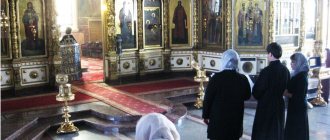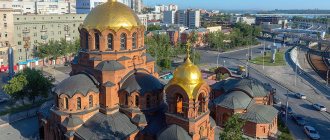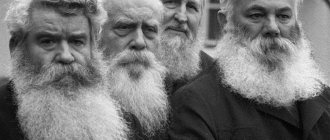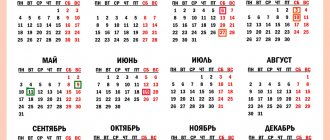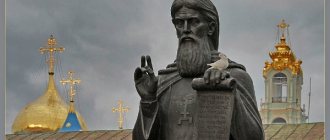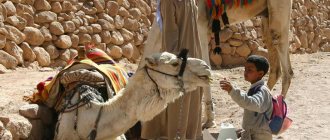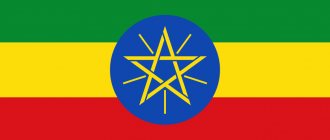Digest “WEEK” - Orthodox news for the week"
Subscribe Free "Golden" newsletter.
Subscribers 4,091 RSS
| July 2021 | ||||||
| 1 | 2 | 3 | 4 | |||
| 5 | 6 | 7 | 8 | 9 | 10 | 11 |
| 12 | 13 | 14 | 15 | 16 | 17 | 18 |
| 19 | 20 | 21 | 22 | 23 | 24 | 25 |
| 26 | 27 | 28 | 29 | 30 | 31 | |
Haven't gone out once in the last 60 days
Mailing site: https://www.sedmica.orthodoxy.ru Opened: 03-12-2001 Author’s address
Author pel73
every week we collect for you fresh, interesting, and simply entertaining
religious and semi-religious news and events, “we squeeze out the water” - we get
a digest
. All you have to do is read and draw your own conclusions. Subscribe and you won't regret it!
Statistics
4,091 subscribers 0 per week
- Issues
- Statistics
Issues
Statistics
HEADLINES OF THE 651st NEWS DIGEST:
Subscribe
* The Patriarch and the Primate of the UOC expressed condolences to the French people * Patriarch Kirill: Terrorism is a diagnosis of human civilization * The Rivne diocese calls on supporters of the UOC-KP to stop the hunger strike in the church * Greece: Neopagans are ready to start > against Christians * Patriarch Kirill: New martyrs are heroes * Church without priests: 2,300 parish churches in Greece were left without pastors * The authorities transferred the temple of the village of Ptichya for alternate use * >: a conference on the dangers of yoga was held in Greece * The court defended the right of the UOC community to the temple of the village of Kolosova * The case of the seizure of the temple of the village of Ugrinov was returned for pre-trial investigation * A church in the Sarny diocese of the UOC was robbed and set on fire * Ivan Okhlobystin will return to church service * His Holiness Patriarch Kirill is 69 years old! * Patriarch Kirill expressed condolences in connection with the death of the hostages as a result of a terrorist attack in the capital of Mali * The stolen icon was returned to the temple in the Kiev region * > launched a service to solve psychological problems * In Karachay-Cherkessia, desecration...
2015-12-14 23:46:25 + Comment
HEADLINES OF THE 649TH NEWS DIGEST:
Subscribe
* The UOC community proved its case in court * Primate of the UOC to believers Ugrinova: > * The court defended the rights of the UOC community to the Paraskevi Church in the village of Chudnitsa * The OCA Synod defrocked an archbishop accused of sexual abuse * The Russian Church is outraged by the incident in one of the Moscow schools with a girl with Down syndrome * Patriarch Bartholomew said that he would never recognize Metropolitan Rostislav as the Primate of the Orthodox Church of the Czech Lands and Slovakia * Through prayers at the Belt of the Virgin Mary, an elderly Greek was healed of hepatitis * The St. Vladimir Marathon took place for the first time in Kiev * God does not give Ukraine worthy rulers , because the people do not pray for this * Spiritual > will be held in the Tulchin diocese * An ancient well of St. Theodosius of Pechersk was found * The Synod of the UOC elected new bishops, established a day of remembrance of all holy warriors and returned Valentin Lukiyanik to communion with the Church * 25th anniversary of the granting of independence notes the Ukrainian Orthodox Church * A church watchman was killed in the town of Popasnaya, Luhansk region *…
2015-12-12 00:47:00 + Comment
What you can do and what you can’t afford during Trinity Week
Trinity Day is often called the “Birthday of the Church.” It is also called Pentecost. On the Day of the Holy Trinity, for the first time after Easter, the prayer “To the Heavenly King” is read. On this great day - the birthday of the Church, after the Liturgy, Vespers is served, during which kneeling prayers are read - amazing in their depth and beauty.
- We must wait for summer from this week and dress in everything green and colorful.
- You can tell fortunes to the girls with a wreath this week.
- You need to weave yourself a wreath from fresh birch branches and put it on your head right away.
- Wearing this wreath you need to go to the nearest river.
- Then you need to throw a wreath into the water and watch it float.
- If the wreath reluctantly leaves the shore, then it is too early for the girl to think about marriage.
- But if the wreath quickly floats into the distance, it means that it’s high time for the girl to get married.
- You should not allow yourself to overeat this Holy Week.
- In the old days they did not build fences on Trinity Week because they were afraid of the birth of deformities in cattle. The old people said that building a fence could certainly lead to this.
- You shouldn’t let sinful thoughts into your head either.
- We need to pray a lot and meditate on our three-faced God.
HEADLINES OF THE 648TH NEWS DIGEST:
Subscribe
* The Ternopil diocese will protect its churches from schismatics * Church architects supported the project to revive the Tithe Church * The Serbian bishop called on the believers of the UOC to be faithful to their Church to the end * Priest Fyodor Konyukhov will open a children's school for travelers * The UOC delegation took part in the Trinity-Sergius celebrations * Patriarch Neophyte: The seizure of churches does not contribute to peace between Christians * Five thousand believers held a religious procession in Zaporozhye * Archimandrite Victor (Kotsaba): The cessation of hostilities in Donbass is the merit of those who pray * Theology has officially become a scientific specialty in Russia * Residents of the Greek village of Soho testify about a miracle through the prayers of the Mother of God * Accusations that the UOC is an instrument of the Kremlin’s policy are unfounded * Grand Prix > received the film > * More than 70 tons of food were transferred to the Gorlovka and Severodonetsk dioceses * The church patron arbitrarily transferred the community of the Gorlovka diocese into schism * To the elderly nuns of the almshouse grievous bodily harm was inflicted...
2015-12-10 21:45:08 + Comment
HEADLINES OF THE 647TH NEWS DIGEST:
Subscribe
* The Patriarchate of Jerusalem recognizes only the canonical Church in Ukraine * The Patriarch of Jerusalem discouraged the deputies > * Hierarchs of the Cypriot Church expressed support for the Primate of the UOC * Believers of the village of Chumaki rejected the offer to move to > * The Church celebrated the Council of Vinnitsa Saints for the first time * Bishop Clement: The information war against the Church is manipulative * The first consecration of the temple after the cessation of shelling took place in Lugansk * The vicar of the Kiev-Pechersk Lavra asks journalists to leave him alone * Crimes against the clergy will be discussed at a meeting with law enforcement officers * Prayers for those serving and killed in Donbass will be offered in Zaporozhye * Patriarch Kirill: We must realize the importance of preserving the family * > will continue to publish anti-church stories * Representatives of Local Churches called on the people of Ukraine for reconciliation * Foreign journalists were provided with facts of violation of the rights of believers of the UOC * The image of St. Sergius of Radonezh in the city of Smela was again myrrhized * Manager of the affairs of the UOC: A military solution to the situation...
2015-11-04 22:39:30 + Comment
HEADLINES OF THE 646TH NEWS DIGEST:
Subscribe
* During the year, schismatics seized more than 30 churches of the UOC, three clergy were killed * Phanar cannot recognize a non-canonical denomination unilaterally * The Romanian Patriarchate will cooperate with the Ministry of Health * The Kolosova community met with the head of the Ternopil Regional State Administration * The Synod of the Greek Orthodox Church responded to the Greek Minister of Economy * Patriarch Kirill asks the Moscow authorities to restore the ancient monastery * The Patriarchate of Georgia calls on the authorities of Georgia and Azerbaijan to investigate the footage distributed on the Internet * The SBU accused two priests of anti-state propaganda * Archimandrite Victor (Kotsaba): It is possible to demonstrate a civic position only within the framework of the law * Vladimir Legoyda: Churches do not political power is needed, its task is to change the human heart * The relics of saints found during the dismantling of the foundation of the house were transferred to the Rostov-on-Don Cathedral * The Primate of the Albanian Church to the faithful of the UOC: Do not be afraid, our hope is Christ! * The murder of a nun of the Florovsky Monastery has been solved * Bishop Bogolep tells...
2015-09-15 20:54:58 + Comment
History[ | ]
The team of the future Church-scientific center of the Russian Orthodox Church “Orthodox Encyclopedia” began to be created on the basis of the classical literature department of the Literary Studies magazine, which was headed by Sergei Kravets since 1988[3]. On the pages of the magazine, which was not very popular at that time, works by Vladimir Solovyov, Vasily Rozanov, Alexei Losev, priest Pavel Florensky, “Note on Ancient and New Russia” by N. M. Karamzin and others began to be published. Translations of the New Testament were published in the magazine, which contributed to the growth of circulation and popularity of the publication[4].
At the end of 1990, on the initiative of Abbot Andronik (Trubachev), the publishing house of the Spaso-Preobrazhensky Valaam Monastery was created in Moscow. In February 1991, Patriarch of Moscow and All Rus' Alexy II issued a decree on the creation of the Valaam Publishing House, which established its legal status. At that time, the publishing house consisted of several employees and was located in a single room in the editorial office of the Literary Studies magazine. Later the publishing house moved to the courtyard of the Spaso-Preobrazhensky Valaam Monastery[5].
From the very beginning of its activity, the publishing house was engaged in the publication of serious scientific and historical works. Monuments of early Christian and ancient Russian literature were published, which became classic works of pre-revolutionary church scholars, which needed to be returned to the reader at the end of the 20th century. The most significant works published during this period include: a two-volume edition dedicated to St. Seraphim of Sarov; “Church History” by Eusebius Pamphilus, “The Enlightener” by St. Joseph of Volotsky; four-volume “Lectures on the history of the ancient Church” by V.V. Bolotov; “Illustrated history of religion” in two volumes, published in Russia at the beginning of the 20th century and other publications[5]. All these publications were previously available only to a narrow circle of readers[4]. As noted on the website of the CSC “Orthodox Encyclopedia”: “The basis of success, undoubtedly, was passion - in the future it manifested itself brighter and brighter - passion, sometimes supported by donations from people who sought to help a small team (not with sponsorship millions, but with a bag of sugar or fish canned food)”[4].
In 1993, it was decided to publish for the 850th anniversary of Moscow the fundamental “History of the Russian Church” based on the famous work of Metropolitan Macarius (Bulgakov), supplementing it with voluminous scientific comments, prefaces and indexes[5]. For this purpose, a Scientific Editorial Council was formed, which, on behalf of Patriarch Alexy II, was headed by Archbishop Arseny (Epifanov) of Istra. Since previously there was no such experience of interaction between secular and church scientists, “both representatives of church science, of whom there were not many, and representatives of secular science, at the time of the beginning of our joint work, treated each other with some caution. Secular scientists assumed that unconditional adherence to the church point of view would be imposed on them; they feared that tradition would dominate the scientific approach. And church scientists, who grew up, in general, in isolation from big science, in theological academies and seminaries, imagined that they would have to defend church foundations from the attacks of secular science”[6]. However, very quickly such tension disappeared. “In the process of daily joint work, completely new cooperative relationships were built between representatives of secular and ecclesiastical science, which has not happened in Russia for almost a century. This process mutually enriched the scientists and made the work extremely fruitful.”[5].
The first volume of this publication was published in 1994. The reissue of the work of Metropolitan Macarius (Bulgakov) took up the first 7 volumes, but since Metropolitan Macarius’s book ended in the middle of the 17th century, the seventh volume of its new edition was replenished with texts of new research on the history of the Russian Church in the 17th century. In addition, the publication included the work of Professor I.K. Smolich, dedicated to the synodal period, which constituted the eighth volume, published in two books. The final, ninth volume of “History of the Russian Church in the 20th Century” (until 1996) was written by Archpriest Vladislav Tsypin. As part of the same publication, another work by I. K. Smolich, “The History of Russian Monasticism,” was published in a separate volume [5].
As the publication of “The History of the Russian Church” approached its logical conclusion, the question arose of how to preserve a team of secular and ecclesiastical scientists numbering about twenty people, which had proven itself well in terms of scientific research activities? According to Sergei Kravets, “a new task arose for him by itself: starting from the middle of the 19th century, the Orthodox Church, and not only the Russian Church, but all the Local Orthodox Churches, had a grandiose, but never achieved goal - the creation of a fundamental body of knowledge in the form of the “Orthodox Encyclopedia” [5].
On September 10, 1996, by decree of the Patriarch of Moscow and All Rus' Alexy II, the Church-Scientific Monastery was formed on the basis of the publishing house of the Holy Transfiguration Valaam Monastery [2]. On October 10, 1996, the Holy Synod of the Russian Orthodox Church approved the project to publish a 25-volume Orthodox Encyclopedia. To implement the project, the Supervisory, Trustee, Church-Scientific and Scientific-Editorial Councils, and the Association of Philanthropists were formed. Scientific and information support for this project was provided by the synodal commissions and departments of the Moscow Patriarchate, the Russian Academy of Sciences, research institutes, leading religious and secular educational institutions of Russia, archives, museums, and libraries[2].
Since the beginning of 1998, a whole cohort of young specialists, graduates of church universities and Moscow State University named after M.V. Lomonosov[4] came to the Orthodox Encyclopedia Center.
On October 6, 1998, the Holy Synod of the Russian Orthodox Church decided to “consider the timely provision of information of a historical, biographical, statistical and hagiographic nature in connection with the requests of the Church Scientific Center “Orthodox Encyclopedia” mandatory for all institutions of the Russian Orthodox Church”[7].
CSC “Orthodox Encyclopedia” received [ when?
] support of the Moscow Government, a number of regions of the Russian Federation (Saratov, Samara and other regions), industrialists and entrepreneurs united in the Board of Trustees and the Association of Philanthropists of the Orthodox Encyclopedia[2].
On December 22, 2000, by decree of Patriarch of Moscow and All Rus' Alexy II, a Hagiographic Council was formed at the Orthodox Encyclopedia Central Research Center[8], distributing grants among scientists who are engaged in research in the field of Russian hagiography and preparing new editions on the handwritten lives of Russian saints[5] .
On March 26, 2001, in the Sergius Hall of the Cathedral of Christ the Savior, a joint meeting of the Supervisory, Trustee and Public Councils for the publication of the “Orthodox Encyclopedia” was held, at which the 10th anniversary of the Church-Scientific was celebrated [9].
To work on the encyclopedia, the Orthodox Encyclopedia Center was organized [ when?
] archive on the history of the Russian Church of the 20th century[10], where materials from the Patriarchal Office for the years 1925-1943 and personal files of clergy of that time were transferred from the Archive of the Moscow Patriarchate[5]. At the same time, the archive was replenished thanks to the methodological assistance of the State Archives of the Russian Federation.
By the end of 2001, it was decided to use the organizational and intellectual resource of the Church-Scientific not only in preparing the encyclopedia itself. On November 29, 2001, the Internet portal “sedmitza.ru” was launched[11]. On May 3, 2003, the TV Center channel began broadcasting the weekly television program “Orthodox Encyclopedia,” which is designed for a wide range of viewers[12]. Both projects turned out to be in demand[5].
In November 2002 and November 2003, there were refresher courses for the management staff of the Russian Orthodox Church, organized by the Central Scientific Center jointly with the Russian Academy of Public Administration[2]. Speaking at the opening of the courses, the head of the Church Scientific said that in preparing them, the initiators “were based on the fact that in modern Russia any church figure is also a public figure, and, often, a state figure.” “The purpose of organizing such training is to try to equip church leaders with knowledge of modern technologies of communication, interaction with government, public, and commercial structures”[3].
The television group of the Orthodox Encyclopedia, having gained the necessary experience, began creating their own films. The first film that was prepared with the direct participation of the Church-Scientific is the documentary series “Earthly and Heavenly,” shown on the RTR channel in 2004. In the fall of 2005, Patriarch Alexy II issued a decree on the creation of the Cultural Foundation “Film and Television Company “Orthodox Encyclopedia”” at the Church-Scientific Center, closely associated with the Central Scientific Center “Orthodox Encyclopedia”, but with an independent budget[5]. Since January 1, 2006, this organization has carried out all film and television projects of the Orthodox Encyclopedia, including a weekly television program on TVC and the filming of documentaries[13].
On November 29, 2005, at the 13th meeting of the Public, Supervisory and Trustee Councils for the publication of the “Orthodox Encyclopedia”, chaired by Patriarch Alexy II, it was decided to begin publishing the quarterly journal “Bulletin of Church History” in 2006[14]. The need for such a publication arose due to the fact that the center received a lot of research materials and scientific journalistic articles, which, due to their format, could not always be published in the encyclopedia. But since these materials have great scientific value, their publication turned out to be in demand[5].
In 2006, Patriarch Alexy II, taking into account the large number of documentaries that were created by Kino-Television, signed a decree on the creation of a film and photo archive on the history of the Russian Church in the 20th century on the basis of the Church Scientific Center[5].
In April 2010, the Church Scientific Center announced the start of a charity event, the purpose of which is to assist libraries, as well as scientific and educational organizations of the Russian Federation in acquiring collections of scientific literature on the history of the Church[15].
HEADLINES OF THE 645TH NEWS DIGEST:
Subscribe
* In the Philippines, a community of 239 people received Orthodox Baptism * The relics of St. Matthew of Yaransky were found * The case of seizing the temple in Ugrinov was closed: law enforcement officers did not see any crime in the actions of the raiders * Primate of the UOC: A person faithful to God will never leave the Church * Dissenters disrupted the Liturgy on Kiev region and expelled believers from the temple * Primate of the UOC: Only with God's help can the state be successfully developed * On September 14, the UOC will celebrate the Synaxis of the Vinnitsa Saints for the first time * Schismatics occupied the UOC temple in Mizhhirya * Schismatics blocked the highway, demanding that the temple of the canonical Church be handed over to them * Vladimir Legoida called on the media pay more attention to works of mercy and social service * The Serbian Church issued a statement regarding assistance to migrants in Serbia * In response to sanctions, the Valaam Monastery intends to grow up to 200 tons of trout per year * Patriarch Kirill consecrated the Vladimir Church in the monastery at the source of the Dnieper * Patriarch Kirill called for the development of all aspects of the diocese...
2015-09-12 14:17:55 + Comment
Holy Week
Good Friday.
Crucifixion, VIII century, Sinai About the passion of the Savior and Holy Week
- Holy Week: the most important things
- Venerable Ephraim the Syrian. Homilia on the Passion of the Savior
- Metropolitan Athanasius of Limassol. The meaning of the Passion and Resurrection
- Archpriest Andrey Tkachev. “Gospel Concentrated”: A Conversation on Holy Week
- Hegumen Nektary (Morozov). Just because He called
- Hieromonk Irenaeus (Pikovsky). Lecture 24. Holy Week: from the Entry of the Lord into Jerusalem to the Last Supper (Orthodox educational courses)
- Hieromonk Dorotheos (Baranov). “I see Your palace...”
- Deacon Vladimir Vasilik. Don't be afraid of the end of the world! Reflections on the hymns of Holy Week
- Anna Saprykina. During Holy Week with children (maternal notes)
- Yuri Kishchuk. Fear and conscience. Thoughts for Holy Week
Days of Holy Week
- Maundy Monday
- Maundy Tuesday
- Great Wednesday
- Great Thursday
- Great Heel
- Holy Saturday
Divine service
- Hymns of Holy Week
Liturgical features of Passion
- Nikolay Zavyalov. Order of ringings performed during Holy Week
- Hermogenes Shimansky. Liturgics. Holy Week
- Priest Mikhail Zheltov. General composition of the services of Holy Week
Iconography
- Iconography of Holy Week. PHOTO GALLERY
***
Holy Week, or Holy Week, is the last week before Easter, dedicated to memories of the last days of the Savior’s earthly life, His suffering, crucifixion, death on the cross, and burial. This week is especially honored by the Church. “All days,” says the Synaxarion, “are surpassed by the Holy and Great Pentecost, but greater than the Holy Pentecost is the Holy and Great Week (Holy Week), and greater than the Great Week itself is this Great and Holy Saturday. This week is called Great not because its days or hours are longer (than others), but because during this week great and supernatural miracles and extraordinary deeds of our Savior took place..."
Good Friday. Crucifixion. Fresco of the Church of St. Nicholas in Prilep, Macedonia. XII-XIII centuries
According to the testimony of St. John Chrysostom, the first Christians, burning with the desire to relentlessly be with the Lord in the last days of His life, during Holy Week intensified their prayers and intensified the ordinary feats of fasting. They, imitating the Lord, who endured unprecedented suffering solely out of love for fallen humanity, tried to be kind and lenient towards the weaknesses of their brothers and to do more works of mercy, considering it indecent to pronounce condemnation in the days of our justification by the blood of the Immaculate Lamb, they stopped all litigation and trials in these days , disputes, punishments, and even released for this time from chains prisoners in dungeons who were guilty of non-criminal crimes.
Every day of Holy Week is great and holy, and on each of them special services are held in all churches. The services of Holy Week are especially majestic, adorned with wisely arranged prophetic, apostolic and evangelical readings, the most sublime, inspired chants and a whole series of deeply significant, reverent rituals. Everything that in the Old Testament was only foreshadowed or said about the last days and hours of the earthly life of the God-Man - all this the Holy Church brings together into one majestic image, which is gradually revealed to us in the Divine Services of Holy Week. Remembering in the Divine Service the events of the last days of the Savior’s earthly life, the Holy Church watches every step with an attentive eye of love and reverence, listens attentively to every word of the Savior coming to the free passion of Christ, gradually leads us in the footsteps of the Lord throughout His entire Way of the Cross, from Bethany to Skull places, from His royal entry into Jerusalem until the last moment of His redemptive suffering on the cross, and further - until the bright triumph of Christ’s Resurrection. The entire content of the services is aimed at bringing us closer to Christ through reading and singing, making us capable of spiritually contemplating the mystery of redemption, for the remembrance of which we are preparing.
The first three days of this week are devoted to intensive preparation for the passion of Christ. In accordance with the fact that before his suffering Jesus Christ spent all his days in the temple, teaching the people, the Holy Church distinguishes these days with especially long Divine services. Trying to gather and focus the attention and thoughts of believers in general on the entire Gospel history of the incarnation of the God-man and His ministry to the human race, the Holy Church reads the entire Four Gospels on the clock during the first three days of Holy Week. The conversations of Jesus Christ after entering Jerusalem, addressed first to the disciples, then to the scribes and Pharisees, develop and are revealed in all the hymns of the first three days of Holy Week. Since in the first three days of Holy Week various significant events took place that are most closely related to the passion of Christ, these events are reverently remembered by the Holy Church on the very days on which they took place. Thus, the Holy Church these days relentlessly leads us following the Divine Teacher, with His disciples, now to the temple, now to the people, now to the tax collectors, now to the Pharisees, and everywhere enlightens us with the very words that He Himself offered to His listeners in these days. days.
Preparing believers for the Savior's suffering on the cross, the Holy Church gives the Divine service of the first three days of Holy Week the character of sadness and contrition for our sinfulness. On Wednesday evening, the Lenten Divine service ends, the sounds of weeping and lamentation of the sinful human soul fall silent in church hymns, and the days of another mourning begin, permeating the entire Divine service - weeping from the contemplation of the horrific torment and suffering on the cross of the Son of God Himself. At the same time, other feelings - indescribable joy for one’s salvation, boundless gratitude to the Divine Redeemer - overwhelm the soul of a Christian believer. Mourning the innocent sufferer, mocked and crucified, shedding bitter tears under the cross of our Savior, we also experience inexpressible joy from the knowledge that the Savior crucified on the cross will resurrect us, who are perishing, with Himself.
Being present during Holy Week at church services, which represent all the events of the last days of the Savior as if taking place before us, we mentally go through the entire majestically touching and immensely edifying story of the suffering of Christ, with our thoughts and hearts “we descend with Him and are crucified with Him.” The Holy Church calls us this week to leave everything vain and worldly and follow our Savior. The Fathers of the Church composed and arranged the services of Holy Week in such a way that they reflect all the suffering of Christ. The temple these days alternately represents either the Upper Room of Zion, Gethsemane, or Golgotha. The Holy Church surrounded the services of Holy Week with special external grandeur, sublime, inspired chants and a whole series of deeply significant rituals that are performed only during this week. Therefore, whoever constantly attends services in church these days apparently follows the Lord, who is coming to suffer.
Monday, Tuesday and Wednesday of Holy Week are dedicated to the recollection of the Savior’s last conversations with his disciples and people. On each of these three days, the Gospel is read at all services; all four Gospels are required to be read. But whoever can, must certainly read these passages from the Gospel at home, both for himself and for others. Instructions on what to read can be found in the church calendar. When listening in church, due to the large amount of reading, much can escape attention, but reading at home allows you to follow the Lord with all your thoughts and feelings. When you carefully read the Gospels, the suffering of Christ, coming to life, fills the soul with inexplicable tenderness... Therefore, reading the Gospel, you are involuntarily transported in your mind to the scene of events, you take part in what is happening, you follow the Savior and suffer with Him. Reverent reflection on His suffering is also necessary. Without this reflection, being present in church, hearing, and reading the Gospel will bring little fruit. But what does it mean to meditate on the sufferings of Christ, and how to meditate? First of all, imagine in your mind the suffering of the Savior as vividly as possible, at least in its main features, for example: how He was betrayed, judged and condemned; how He carried the cross and was lifted up to the cross; how he cried out to the Father in Gethsemane and on Golgotha and surrendered His spirit to Him: how he was taken down from the cross and buried... Then ask yourself why and for what purpose He who had no sin, and Who, as the Son of God, endured so much suffering , could always abide in glory and bliss. And also ask yourself: what is required of me so that the Savior’s death does not remain fruitless for me; What must I do to truly participate in the salvation purchased at Calvary for the whole world? The Church teaches that this requires the assimilation by mind and heart of the entire teaching of Christ, the fulfillment of the commandments of the Lord, repentance and imitation of Christ in a good life. After this, conscience itself will answer whether you are doing this... Such reflection (and who is not capable of it?) surprisingly quickly brings the sinner closer to his Savior, closely and forever in a union of love connects him with His cross, strongly and vividly introduces him into the participation of the one who what happens at Golgotha.
The path of Holy Week is the path of fasting, confession and communion, in other words, fasting, for worthy communion of the Holy Mysteries on these great days. And how can one not fast in these days, when the bridegroom of souls is weaned (Matthew 9:15), when He Himself hungers at the barren fig tree, thirsts on the cross? Where else can one lay down the burden of sins through confession, if not at the foot of the cross? What better time to receive communion from the Cup of Life than in the coming days, when it is given to us, one might say, from the hands of the Lord Himself? Truly, whoever, having the opportunity to begin the Holy Meal these days, evades it, deviates from the Lord, runs away from his Savior. The path of Holy Week is to provide, in His name, help to the poor, sick and suffering. This path may seem distant and indirect, but in fact it is extremely close, convenient and direct. Our Savior is so loving that everything we do in His name for the poor, sick, homeless and suffering He takes personally to Himself. At His Last Judgment He will demand from us especially works of mercy towards our neighbors and on them He will establish our justification or condemnation. Keeping this in mind, never neglect the precious opportunity to alleviate the suffering of the Lord in His lesser brethren, and especially take advantage of it during the days of Holy Week - by dressing, for example, a needy person, you will act like Joseph, who gave the shroud. This is the main thing, accessible to everyone, with which an Orthodox Christian in Holy Week can follow the Lord who is coming to suffer.
HEADLINES OF THE 644TH NEWS DIGEST:
Subscribe
The Russian Church has established a day of special prayer for God's creation * Primate of the UOC: I don’t see a greater patriot than our Church * Primate of the UOC: The authorities must stop the war in Donbass * Archbishop Luke of Zaporozhye spoke out against fetal medicine * Volyn diocese promises support for the Ugrinov community * The temple of the village of Ugrinov will be divided between two communities * The Spiritual Cathedral: The Pochaev Lavra is threatened with a forceful takeover * Deputies in Volyn are again interfering in the religious sphere * The incident in Lisichansk is an attempt to undermine the inter-religious conflict * The memory of those killed in > was honored in Gorlovka * Patriarch Kirill addressed a message to the presidents Russia and Ukraine * The Primate of the UOC told the President how to change life for the better * The Ukrainian Orthodox Church celebrated the Day of the Baptism of Russia * The Bashukov community intends to defend its rights to the temple * Believers of the Ternopil region recorded a video appeal to the authorities * The court overturned the discriminatory decision of the Kiev City Council * Priest Roman was killed in Kiev Nikolaev and the monks...
2015-09-10 13:39:56 + Comment
HEADLINES OF THE 643rd NEWS DIGEST:
Subscribe
* The Rivne diocese is concerned about the politicization of church life in the media * Believers help fellow villagers affected by a tornado * The community expelled by schismatics prayed at the walls of their church * Supporters of the UOC-KP tried to seize the church of. Popelnya * The schismatics cannot register the captured temple in the Ternopil region * An unknown skete of the Zaporozhye Cossacks was found on Athos * The bishop called on the Cossacks to carry out an action > * An icon stolen from the Kiev Pechersk Lavra was found * The church honored the memory of His Beatitude Metropolitan Vladimir * The memory of His Beatitude Metropolitan Vladimir was honored on Athos * The Russian Church called on Ukrainian politicians not to encroach on church unity * Celebrations in honor of the Baptist of Rus' will be attended by six miraculous icons * Ukrainians are advised to rely on God * Referendum in Greece: As the confessors called, the people said > * The Primate of the UOC called on Christians to check their lives with Gospel * Paganism leads to the loss of moral guidelines * Holy Synod of the Cyprus Church: It is unacceptable to…
2015-08-18 21:10:17 + Comment
Notes[ | ]
- Pavel Merzlikin.
An analogue of Wikipedia will be created in Russia.
The project will be carried out for two billion rubles by the publisher of the Orthodox Encyclopedia (unspecified)
.
meduza.io
(November 22, 2019). - ↑ 12345
Church-scientific center of the Russian Orthodox Church “Orthodox Encyclopedia” // Patriarchia.ru - ↑ 12
Where did the “Orthodox Encyclopedia” come from... // Portal-Credo.Ru, 01/10/2003 - ↑ 1234
To the 50th anniversary of Sergei Leonidovich Kravets // Week. Ru, 03/07/2012 - ↑ 123456789101112
Kravets S. L. Church-scientific // Journal of the Moscow Patriarchate. 2007. - No. 4 - P. 54-65 - To the 60th anniversary of Metropolitan Arseny of Istra (unspecified)
.
Church-Scientific
(March 3, 2015). - Meeting of the Holy Synod on October 6, 1998. Archived copy of March 4, 2021 on the Wayback Machine // Russian Orthodox Church Department for External Church Relations, 10/21/1998
- Andrey Salnikov To support church science // Vologda diocesan newspaper “Blagovestnik” No. 11-12 (79-80) 2001
- The most powerful church-scientific project turned 10 years old Archived copy of May 21, 2008 on the Wayback Machine // Pravoslavie.ru, 03/27/2001
- An exhibition of materials from the collections of the Russian Civil Aviation has opened // Sedmitsa.ru, 05/14/2002
- Church-Scientific
- Religious information and encyclopedic program “Orthodox Encyclopedia” // “TV Center”
- 14th meeting of the Councils on the publication of the “Orthodox Encyclopedia” (commentary in the light of faith) // Sedmitsa.ru, 06.06.2006
- The Primate headed the 13th meeting of the Councils on the publication of the “Orthodox Encyclopedia” // Patriarch and the People, 11.29.2005
- Charity event of the Church-scientific // Sedmitsa.Ru, 04/20/2010
HEADLINES OF THE 642nd NEWS DIGEST:
Subscribe
* The UOC denied information about the transfer of 12 parishes to the UAOC * Raskolniki Popelni > UOC church using administrative resources * In the Rivne region, based on a complaint from believers, the work of the village council will be checked * The Synod of the Greek Church considers yoga incompatible with the Christian faith * Archbishop of Athens Jerome sent an open letter to the Minister of Justice of Greece * Patriarch Kirill: The West is in a deep spiritual crisis * The UOC announced the seizure of a temple in the Ternopil region * Behind-the-scenes negotiations with the Phanar are futile, the UOC believes * The Cathedral of Sumy is under threat of destruction * The Saratov Metropolis commented on the consecration of an icon depicting Joseph in Engels Stalin * Russia will formalize the rights to the real estate of the Alexander Metochion in Jerusalem * All-Ukrainian telephone line > - 1 year * Seven Orthodox churches took part in the Night of Temples of the Czech Lands and Slovakia * 102 tons of products were donated to residents of south-east Ukraine by representatives of the Church * The Theological Institute in Paris suspends your activities * > th…
2015-07-09 19:51:23 + Comment
- 1
- …
What prayers to read in the morning and evening during Trinity Week
The significance of the Trinity holiday is so great that some compare it with Easter. The triumph of the Orthodox on this day is due to the fact that the Third Hypostasis of the Lord was revealed to people - the Holy Spirit.
If you have an icon called “The Holy Trinity,” then next to it you can read prayers in the mornings and evenings this week. If there is no such icon, then any one with an image of the Lord will do.
“Lord Almighty, protect my family from sin and forgive us sinners for all our unkind deeds. Amen!” - this prayer can be read every day.
